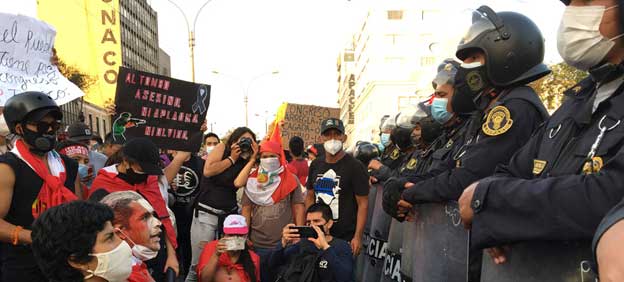The Dictators Daughter or the Farmers Son?

LIMA, Peru, Jun 21 (IPS) - Peru’s first round of elections on 11 April saw voters choosing between 18 presidential candidates with no one candidate leading by an impressive margin.
Pedro Castillo, a rural teacher and union leader of the left-wing, socially conservative political party Peru Libre (Free Peru), emerged with a surprise lead of 18.9 per cent. His opponent, Keiko Fujimori, daughter of the imprisoned dictator Alberto Fujimori and third time presidential candidate of the right-wing Fuerza Popular (Popular Force) trailed with 13,4 per cent.
Similarly, the 130 seats in the new congress will be shared amongst 10 political parties, with no one party holding a majority.
Some 30 per cent of the electorate did not vote at all – and this in a country where voting is mandatory. The low participation reflects the general aversion towards the rampant political corruption, scandal and instability of the past decades.
The mood is of a people fed-up with a self-serving political class in which personal economic interests have scarcely become distinguishable from political goals.
Add to this that many stayed away from the polling stations for fear of contracting Covid-19 in highly-infected Peru, with others having more pressing matters to tend to, like queuing for days to fill oxygen tanks for their loved ones.

The results of the first round left Peruvians with the disturbing choice between two extremes. Since then, both candidates have had no choice but to moderate their rhetoric. Nevertheless the divisions remain deep-seated.
On the one hand, white, wealthy urban voters are eager to maintain their supposed economic stability and opted for the status quo candidate Fujimori. On the other, the mixed-race and indigenous, rural voters are eager to escape their impoverished reality and to finally be seen and heard by ‘one of their own’, Castillo.
These opposing realities are reflected in the narrow results of the second election round on 6 June in which Castillo leads by a mere 0,25 per cent or 44,058 votes at a slightly higher turnout of 75 per cent.
Even though Castillo declared himself the winner on 15 June, as of 17 June, the National Election Board (JNE) has yet to make an official declaration; it will do so only after the requests to annul specific voting records, submitted by both parties, are resolved in the next weeks.
A stress test for Peru's democracy
In the 11 days since the run-off elections, tensions have been boiling high, solidifying divisions and putting Peru’s democratic system under a stress test that raises concerns about the country’s future stability.
In the frenzy to stoke distrust, undermine the democratic process, and win the elections, Fujimori’s team of lawyers attempted to tip the election balance in her favour by requesting the nullification of some 200,000 votes in Castillo-strong rural areas.
The request was based on unsubstantiated claims of fraud. International election observers have judged the election free and fair.
Regardless of which candidate will preside in the end, they will be faced with a range of complex challenges.
The country remained in limbo until 12 June when the National Election Jury (JNT) finally rejected these requests and, most importantly, did not cave to pressures to extend the 9 June deadline for presenting nullification cases.
Since then, Fujimori supporters have been bashing the JNT for this decision, calling for new elections, with some high-ranking retired military officials even suggesting a coup d’état.
The armed forces were thankfully quick to release a communiqué stating their intention to respect constitutional and democratic order. The reactions of both the JNT and the armed forces are examples signalling that the democratic system is still working and being respected.
Peru's overlapping crises
Regardless of which candidate will win in the end, they will be faced with a range of complex challenges: Peru is experiencing a loss of trust in its democratic system, its institutions and its politicians.
The mistrust in politicians of whichever political tendency is widespread and, frankly, justified. Excluding the latest two interim presidents, not one of the last six presidents has been spared from corruption scandals, convictions or both.
Moreover, the Covid-19 pandemic has exposed and exacerbated Peru’s pre-existing inequalities. It has left a populace traumatised by sickness with the highest per capita death rate in the world. Decades of underinvestment in the health system, the lowest in Latin America after Venezuela, has made matters worse.
At the same time, monetary poverty has increased from around 20 to 30 per cent during the pandemic, representing approximately 10 million people or nearly a third of the population.
Add another 11 million people believed to be only marginally above the poverty line and you have two-thirds of the population badly hurting and facing severe food insecurity. A life of precarity is the reality of approximately 90 per cent of the rural population and not surprisingly, the source of Castillo’s base.
Faced with these enormous challenges, how do the two presidential candidates intend to heal their nation's problems?
Fujimori's lack vision, Castillo's big challenge
The main risk to a Fujimori presidency is her lack of a clear vision. She has yet to comprehend that the vast majority of the population has passed the tipping point. Her fundamental inability to grasp a deeper understanding of the structural and systemic inequalities permeating Peruvian society is a real problem.
Long-standing social shortcomings in health care, education, and housing cannot be placated by throwing money at the problems. Yet this is exactly what her superficial social policy portends.
She would respect labour rights, financially compensate every Peruvian family that lost someone to Covid-19, grant 2 million land titles, offer loans to small businesses, and deliver free water to communities not on the supply grid.
The challenges facing a Castillo presidency, on the other hand, are far greater than for Fujimori.
Fujimori plans to only tweak the neoliberal economic model installed by her father under his 10-year presidency (1990 to 2000) and pursued by the presidents that followed.
Further, she seeks to maintain a constitution elaborated under her father’s presidency, which leaves little room for the corrective forces of government intervention, but ample room for free-market forces.
The challenges facing a Castillo presidency, on the other hand, are far greater than for Fujimori. The strength and pressure of economic interest groups hold sway over sitting parliamentarians as well as the commercial mainstream media.
During the election campaigns, media conglomerates have had one objective in mind: to demolish Castillo and promote Fujimori. The scare-mongering tactics painting Castillo as a dangerous communist and terrorist threat have progressively reduced his almost 20 per cent lead in the immediate aftermath of the first elections.
Biased attacks will no doubt continue under a Castillo presidency.
Castillo’s economic discourse has moved from one of nationalising key industries, especially in the mining sector, to one of ‘renegotiating contracts’ with large companies, spending 20 per cent of GDP on education and healthcare, reforming the pension system, decentralising public universities, and redrafting the constitution to strengthen the role of the state.
Despite recruiting Pedro Francke, former economic advisor to centre-left Veronica Mendoza of the party Nuevo Perú (New Peru), financial markets are still nervous and wealthy Peruvians are already moving their money out of the country.
The traditional power struggles between the executive and legislative branches of government would also continue under his presidency. A fragmented, largely conservative Congress is unlikely to sign off on his economic plans, especially if they entail nationalising the big revenue mining industries, and costly social programmes.
The omnipresent threat of a parliamentary coup is real and relatively easy through the use of the procedure for ousting a president on the grounds of their ‘moral (in) capacity’.
Against this backdrop of acute national challenges, emotionally-charged societal divisions, and a self-interested political class, further political instability if not turmoil and massive social unrest cannot be ruled out.
The much-awaited official declaration of the next president will not end the current political crises; it is merely the beginning of the next chapter in Peru’s troubled political history.
Source: International Politics and Society, published by the International Political Analysis Unit of the Friedrich-Ebert-Stiftung, Hiroshimastrasse 28, D-10785 Berlin.
Follow @IPSNewsUNBureau
Follow IPS New UN Bureau on Instagram
© Inter Press Service (2021) — All Rights Reserved. Original source: Inter Press Service
 Global Issues
Global Issues